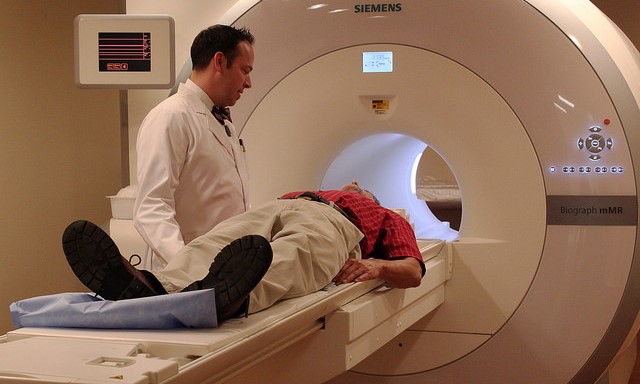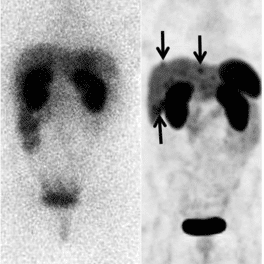Carcinoid Syndrome Tests
Home » For Patients old » Living with NETs » Carcinoid Syndrome » Carcinoid Syndrome Tests

Testing for carcinoid syndrome
A variety of tests are used to detect and monitor neuroendocrine tumors and carcinoid syndrome, including laboratory tests, and various imaging tests such as PET/CT, MRI, and increasingly sophisticated nuclear medicine studies.
- Laboratory tests focus on detecting the substances (e.g., serotonin) that a neuroendocrine tumor produces that cause carcinoid syndrome symptoms.
- Imaging tests are used to locate the tumor and evaluate the extent of the disease, for instance, if the cancer has spread.
- Other diagnostic tests include upper and/or lower GI endoscopy, with or without ultrasound, to locate tumors and even remove a small piece for testing (called a biopsy).
Below you will find more information about the types of tests your doctor may order for carcinoid syndrome.1,2,3,4
Laboratory tests for carcinoid syndrome
5-HIAA urine test
Because excessive serotonin is one of the main substances responsible for the most commonly encountered midgut carcinoid syndrome, a 24-hour urine collection to measure 5-HIAA is often the initial diagnostic test a doctor will order to determine if a person has a functional neuroendocrine tumor. 5-HIAA is a substance that is produced from serotonin (5-HT). It is used as an indirect measure of how much serotonin (5-HT) the body is producing.
- This test has a sensitivity as high as 90%, meaning that it will correctly diagnose 9 out of 10 people with the condition.
- The test has a 90% specificity for the disease, meaning that the test will rarely be positive for a person who does not have the disease (false positive). 1,2,3
Blood plasma test for 5-HIAA
This test is like the 24-hour urine test for 5-HIAA but detects 5-HIAA in the blood, instead of urine. This test is convenient; as there is no need to avoid certain foods that can cause falsely increased HIAA. However, it is not yet routinely used as it is more costly and it still needs further validation for its reliability.1
Chromogranin A test
Chromogranin A (CgA) is a substance that is produced by a NET and can be a useful test for detecting NETs that may or may not be producing other active substances (e.g., serotonin, histamine) known to contribute to carcinoid syndrome. The sensitivity of this test is good (it often identifies people with a NET), but specificity is low (the test may be positive for a person who does not have a NET). There are several commonly encountered causes of elevated CgA that are not due to a NET (such as taking antacid H2 antagonists or proton pump inhibitors) (false positive CgA elevation). This test can be a good follow-up test for a NET after other laboratory tests have been performed. 3
Blood serotonin test
This test, like the 5-HIAA test, is performed to detect the presence of high levels of serotonin; however, the test is not routinely recommended because the specificity of the test is not considered reliable.3
Imaging scans used in carcinoid syndrome testing
Imaging scans help find the location(s) of a neuroendocrine tumor, whether it has spread (metastasized), and where it has spread. Some of the primary scans include a triple-phase abdominal computerized tomography (CT) scan, magnetic resonance imaging (MRI) scan, and somatostatin receptor-based PET scanning.
Triple-phase CT scan
The triple-phase CT scan, which makes a cross-sectional image of the abdomen, is a useful diagnostic test. The CT scan helps evaluate the extent of tumor spread, which, for example, can help guide a surgery plan. 2
MRI scans
Alternately, an abdominal MRI scan may be performed to evaluate the extent of the spread of the tumor and to detect metastases to the liver and mesentery. (Gade A 2020) MRI is particularly useful due to its high sensitivity for liver metastases.3 Other more directed imaging studies such as cardiac MRI may also be performed to evaluate the heart and detect cardiac metastases.2
Somatostatin receptor (SSTR)-based imaging
SSTR-based imaging techniques involve intravenous administration of a radioactive tracer that is attached to an analog that can bind to somatostatin receptors when present on the tumor cell surface to visualize and locate the NET.2,3
Two common tests that you may encounter include the Octreoscan and the Gallium 68 (Ga-68) DOTATATE PET scan, a newer scan that offers sharp, detailed images.
Other diagnostic tests for carcinoid syndrome
Echocardiography (TTE)
TTE may be performed in patients with carcinoid syndrome when symptoms suggest there is cardiac involvement.2
Endoscopy
Endoscopy of the gut and occasionally lung (bronchoscopy) may be performed to locate the NET and may be combined with a biopsy to diagnose and characterize the tumor based on tissue pathology.3 Capsule endoscopy and double-balloon endoscopy can also be useful tests for detecting small, difficult-to-locate primary gut carcinoid tumors.2
Learn more about diagnostic testing for neuroendocrine tumors.
Next: Learn about Carcinoid Syndrome Treatment.

Ga-68 Dotatate PET/CT Scan for Neuroendocrine Tumors
If you’ve ever been tested for eyeglasses, you know how one lens can create grainy, foggy images and the next crisp, clear letters. That’s the kind of difference you can see between the Gallium-68 PET/CT scan and prior technology. But are these newer imaging techniques better? And who stands to benefit most from them?

NET Tests & Treatments
Neuroendocrine Tumor Treatments By learning about neuroendocrine tumor (NET) treatment options, you can be more
1 Ferrari A, Glasberg J, Riechelmann R. 2018. “Carcinoid syndrome: update on the pathophysiology and treatment.” Clinics (73) (supp 1): e490s.
2 Gade A, Olariu E, Douthit N. 2020. “Carcinoid syndrome: A review.” Cureus 12 (3): e7186.
3 Pandit S, Annamaraju P, Bhusal K. 2020. Carcinoid Syndrome. Internet: StatPearls. Accessed August 13, 2020. https://www.ncbi.nlm.nih.gov/books/NBK448096.
4 Oncolink. n.d. All About (Neuroendocrine) Carcinoid Tumors. Accessed August 12, 2020. https://www.oncolink.org/cancers/carcinoid-neuroendocrine-tumors/all-about-carcinoid-neuroendocrine-tumors.
